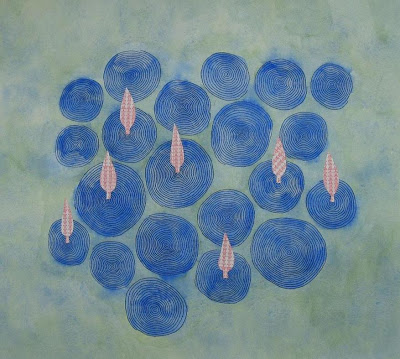


Rafflesia
Wallworks - Doron Yahalom
Exhibition Opening: June 12th, noon
12.06.09-07.07.09
Curator: Irit Segoli
Rafflesia is the name of a huge flower which grows in Southeast Asia and is named after Sir Thomas Stamford Raffles, the British governor of Java in the beginning of the nineteenth century. This flower is parasitic, growing on a host root or trunk, is sharply colored, has a fleshy body and texture and it can grow up to one meter in diameter.
While enlarging and filling in with black industrial paint the photographs of the gaping gun slugs that were taken out of Yitzhak Rabin's body, Doron Yahalom began recalling the rafflesia flower which he recalled from the Ma'ayan Encyclopedia for Youth.
A hole in the head of the slug that enhanced its murderous power created the miniature objects resembling the flower, photographs of which had appeared in Yediot Aharonot on the anniversary of the assassination and which Yahalom had kept for years in a drawer in his study.
This ready-made miniature, which stood opposite the lens of the camera, appears in its third reincarnation in the decorative, flat opaque drawing of Yahalom. The drawing stretches out over the surfaces of Formica tables from IKEA and broadcasts an alienated and defiant
elegance.
The transparency which characterized the sculpture/outline of Doron Yahalom's space in the eighties and the nineties, was exchanged for large and opaque surfaces. The view that appeared then through outlined space is now blocked and covered over. Instead of an opening in the field of vision to the magical views of the lower Galilee that are visible from Kibbutz Ein Dor, where Doron Yahalom was born, raised, lives and works, the opaque surfaces covered in industrial oil paint appear before the viewer.
One may read Yahalom's transition from sculpted drawings to the opaque surfaces as a transition from modernism to post-modernism. At the same time, clearly the socio-political context of the change in the artist's work calls out for attention. While in the first stage of his career, Yahalom maintained a separation between his political resistance to the occupation and his art, this division is now closed: inner penetration and destruction - the principle governing the bullet and outer expansion and flowering - the principle governing the rafflesia - combine here to create a disturbing visual show.
Irit Segoli


ראפלסיה
עבודות קיר | דורון יהלום
פתיחה: יום שישי 12.6.2009בשעה 12:00
נעילה: יום רביעי 7.7.2009
ראפלסיה הוא שמו של פרח ענק הגדל בדרום מזרח אסיה ונקרא כך על שמו של סר תומס סטמפורד ראפלס (Thomas Stamford Raffles ), המושל האנגלי של יאווה בראשית המאה התשע עשרה.
זהו פרח טפיל הצומח על גבי שורש או גזע זר, יש לו צבעוניות חריפה , גוף ומרקם בשרניים והקוטר שלו מגיע עד למטר אחד.
בפרח הראפלסיה, שאותו הכיר באינציקלופדיה לבני-הנעורים "מעין", נזכר דורון יהלום כאשר החל להגדיל ולמלא בצבע "פוליאור" שחור את תצלומי קליעי-האקדח הפעורים, שהוצאו מגופתו של יצחק רבין.
נקב בחוד הקליע שהגביר את עוצמתו הרצחנית, הוא שיצר את האובייקטים המיניאטוריים דמויי הפרח,
שתצלומיהם הופיעו בידיעות אחרונות ביום השנה לרצח ונשמרו במשך שנים במגירה של יהלום.
רדי מייד מיניאטורי זה, שעמד מול עדשת המצלמה, מופיע בגלגולו השלישי בציור הדקורטיבי, השטוח והאטום של יהלום. ציור זה משתרע על פני משטחי שולחנות פורמיקה של "איקאה" ומשדר אלגנטיות מנוכרת ומתריסה.
השקיפות אשר אפיינה את הפיסול/מיתווה בחלל של דורון יהלום בשנות השמונים והתשעים, התחלפה במשטחים גדולים ואטומים. הנוף שהופיע אז דרך מתווי החלל, נחסם עתה וכוסה.
במקום פתיחת שדה הראיה אל נופי הגליל התחתון הקסומים הנשקפים מקיבוץ עין דור, שם נולד, גדל, חי
ועובד דורון יהלום, מופיעים המשטחים האטומים המכוסים בצבע השמן התעשייתי.
אפשר לקרוא את המעבר של יהלום מפיסול רישומי, אל המשטחים האטומים, כמעבר ממודרניזם לפוסט מודרניזם. אך במקביל, דווקא ההקשר החברתי פוליטי של השינוי בפעולת האמן שלו מזדעק כאן.
וכך, בעוד שבשלב הראשון בקריירה שלו שמר יהלום על ההפרדה בין ההתנגדות הפוליטית שלו לכיבוש, לבין הפעולה שלו כאמן, עתה פיצול זה נסגר:
חדירה וחיסול מבפנים,לפי עיקרון הפעולה של הקליע והתפשטות וכיסוי מבחוץ, לפי עיקרון הפעולה של פרח הראפלסיה, חברו כאן למופע ויזואלי מטריד.
אירית סגולי
































